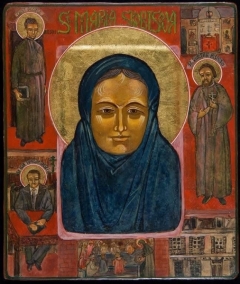Jour de mémoire des néomartyrs de Paris : Mère Marie Skobtsov, Père Dimitri Klépinine, Ilia Fondaminsky, Yura Skobtsov

Nous commémorons ces saints le 20 juillet. Chaque fois que l’on veut en parler on se rend compte à quel point cela est difficile. Tous les quatre sont si différents qu’ils ne rentrent pas dans le cadre habituel des récits hagiographiques. Ils sont différents, même par rapport aux canons de la sainteté et aux représentations de la sainteté dans le milieu chrétien.Une cigarette dans une main, une croix dans l’autre. Des saints qui nous rappellent que le christianisme n’est ni un «confort spirituel», ni un exercice d’auto-flagellation, ni une boutique d’antiquités religieuses, ni un club d’amateurs de théologie raffinée, ni une compétition entre structures et juridictions ecclésiales ni un ensemble d’habitudes pieuses. C’est une co-participation, une co-souffrance, une co-crucifixion.
Pour citer Mère Marie : une «anarchie» qui renverse les hiérarchies terrestres auxquelles il est si confortable de s’accrocher, un vent qui s’engouffre par la porte grande ouverte. Leur sainteté est un défi, un antidote, une révolte, un flot de questions dérangeantes. Une sainteté très inconfortable, impossible à apprivoiser, refusant d’être enfermée dans des «chasubles dorées» — et en même temps, une sainteté profondément biblique.
Le mot biblique en hébreu kadosh, qui signifie « saint » ou « sacré », qui vit « non comme les autres », non pas mieux, mais radicalement autrement.
C’est un radicalisme prophétique et eschatologique.
Nous parlions récemment avec Leonid Dzhalilov du fait que le jour de leur mémoire, qui coïncide avec celui de leur canonisation, tombe dans le calendrier liturgique le même jour que la commémoration du prophète Élie. Est-ce une coïncidence ou une intention délibérée ? Il reste à le comprendre. Mais dans tous les cas, cette coïncidence liturgique avec le jour du prophète de feu renvoie au christianisme de feu de Mère Marie : « Le christianisme, c’est le feu, ou ce n’est rien », et cela jusqu’au « final de feu et de balles ». Peut-être aussi cette coïncidence de dates rappelle-t-elle le chemin brûlant et miséricordieux d’Ilia Fondaminsky, juif chrétien, qui prophétisait la victoire contre la « satanocratie » totalitaire et exerçait une compassion active, y compris envers ceux que les « gens convenables » rejetaient — si semblable à son céleste patron juif.
Depuis leur canonisation, en 2004 une iconographie significative des néo-martyrs parisiens s’est formée. Parmi toutes les icônes connues, celle que je préfère n’est peut-être pas la plus accomplie esthétiquement, mais elle est d’une justesse théologique remarquable. On y voit les quatre dans leurs occupations habituelles : Mère Marie nourrissant les hôtes et pensionnaires de la rue de Lourmel, Père Dimitri à l’écoute d’un interlocuteur invisible, Ilia Isidorovitch Fondaminsky écrivant, Yura Skobtsov sur le point d’ouvrir un livre.
Dans l’éternité, ils travaillent comme ils avaient l’habitude de le faire sur terre. Et c’est sans doute ce qu’ils nous souhaitent aussi.
Par Svetlana Panich, historienne des religions Moscovite de naissance, habite au Canada depuis le début de la guerre de 2022.
***
On the day of commemoration of the new martyrs of Paris Mother Maria Skobtsova, Father Dmitry Klepinin, Ilya Fondaminsky, Yura Skobtsov.
Every time you try to write about them, you realize anew how difficult it is. All four are so unconventional, so « other » that they do not fit into the literary etiquette of narratives about saints. They are even “other” to the hagiographic canon and the ideas about holiness that have developed in the Christian environment.
A cigarette in one hand, a cross in the other. They are saints who remind us that Christianity is not “spiritual comfort,” not self-mortification, not a shop for religious antiquities, a club for lovers of refined theology, a competition between church structures and jurisdictions, or a set of pious habits, but rather “co-participation, co-suffering, co-crucifixion.“
In the words of Mother Maria, it is ”anarchy” that destroys earthly hierarchies, which are so convenient to cling to, it is a wind rushing through an open door. Their holiness is a challenge, an antidote, a rebellion, a heap of uncomfortable questions. A very uncomfortable, untameable holiness that rejects all attempts to encase it in “golden robes” — and at the same time, a very biblical holiness. The biblical kadosh, i.e., holy, means “set apart,” “separated,” living “not like other people,” not better, but radically different. This is a prophetic, eschatological radicalism.
The day of their commemoration, which coincides with the day of their canonization, falls on the day of remembrance of the prophet Elijah in the church calendar. Whether this coincidence is accidental or intentional remains to be seen, but in any case, the calendar’s connection with the day of the fiery prophet brings us back to the fiery Christianity of Mother Maria: “Christianity is fire, or it is nothing,” and so it will be until the very “fiery end.” Or perhaps this coincidence of dates reminds us of the fiery and merciful path of the Jewish Christian Ilya Fondaminsky, who prophesied the victory over totalitarian “satanocracy” and actively sympathized, among others, with those whom “decent people” turned away from. In that, he was very similar to his Jewish heavenly patron.
Since the canonization of the Parisian new martyrs, a significant iconography has developed around them. Of all the known icons, I like the one by Olga Poloukhine that is not the most aesthetically perfect, but very accurate theologically. In it, all four are engaged in their usual activities: Mother Maria feeds the guests and lodgers of Lourmel, Father Dmitry listens to the words of an invisible interlocutor, Ilya Isidorovich Fondaminsky writes or edits something, and Yura Skobtsov is about to open a book.
They work in eternity, as they are accustomed to doing here on Earth. Which is what they wish us to do as well.








